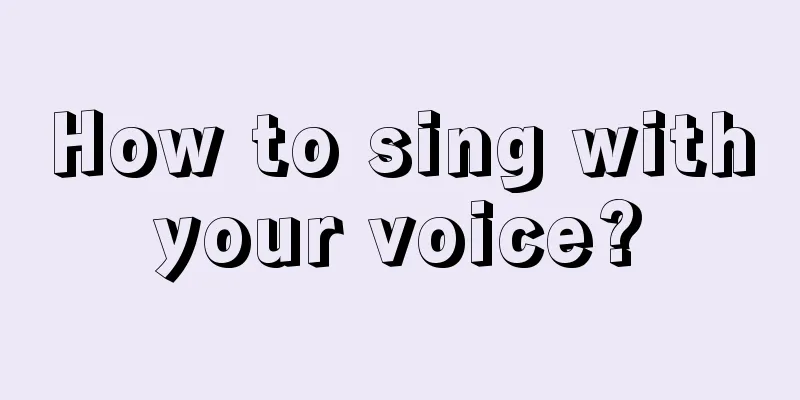How to sing with your voice?

|
Many people like to listen to music, but they are not very good at singing because many people don’t know how to sing with their voice. Usually when they start singing, they sing with their throat, which is not very professional. Many people want to learn songs and want to learn how to sing with their throat. In fact, singing with the throat is very simple. As long as you master a few points, you can sing very nice songs. How to sing with your voice? Let’s take a look at it next. 1. Singing posture is very important Stand up straight, with both legs supporting you evenly. The position of the head is more important than the position of the body. Some people raise their heads when singing high notes, as if this saves some effort, but this is not the case. The head is raised and the high notes are tight. The throat will also feel tight and not loose. The correct answer is: the head should be slightly lowered, but not too low. The head has a lot of resonances, and when sounds resonate in the head, the sounds become louder. The movement of the head should be opposite to the melody, the higher the sound, the slightly lower the head, and the sound seems to go down into the chest cavity. 2. When singing, try to avoid using muscles that are not related to singing. When controlling your breathing with the diaphragm, try not to involve other muscles. Do not exert force as if you were moving something, as that will close all the cavities and also cut off the sound. Don't be nervous when singing, sing naturally, relax your shoulders, don't make small movements, and only use your diaphragm when singing. 3. Open the throat dragon It is very simple to open your throat. When you are sleepy, yawn while talking, and your throat will open. Opening your throat is more important than opening your mouth! The sound you sing in this way will be brighter than just opening your mouth without opening your throat. Therefore, the mouth should open together with the throat, and it is best to open it wider at the back! It is like using an inverted funnel, with the big mouth at the neck and throat, and the tip of the funnel at the mask. If the sound position has completely entered the mask, the sound can gradually be sung from the softest to the loudest. Note: Only open the mouth but not the throat: front mouth and back mouth The mouth is not big, but the throat is open: front mouth and back mouth (inverted funnel) 4. Focus When singing, the sound is like playing a movie. The sound should resonate and the focus should be concentrated on the mask. Neither too far nor too close is good. Everyone has his or her own vocal focus. When the focus is concentrated, the sound will become louder and louder; without focus, the sound will disperse. A loud voice is required, and you cannot just put up a rack in one day. At the beginning, the resonance point should be small, and then expand it, and it will get louder and louder as you sing. This method of producing sound produces a low sound, as if there is a mirror behind the lamp, which can make the light shine farther. The forehead, sinuses and other places are empty resonance cavities, so make the best use of them. 5. Breathing When singing, use the same breathing method as when lying down to sleep. Between chest breathing and abdominal breathing (diaphragm), I prefer abdominal breathing because it allows me to breathe deeply. And quickly. But no matter which type of breathing you use, you cannot use both at the same time! This is contradictory, like stepping on the brake with one foot and the accelerator with the other. 6. Training Sound After you find the best note, sing it up and down without moving your mouth and throat. When singing adjacent notes, try to feel and imitate the best note. This is called "self-imitation." Everyone should have "sound memory". Pay special attention to the feeling of your voice and throat. Singing is very abstract, and you must pay attention to the skill status of vocal organs such as throat tendons. Sound memory not only refers to pitch, but also includes sound quality, timbre, and strength. We should strive for the unity of upper, middle and lower tone ranges. 7. Basic things for vocalization First of all, the throat muscles should move the Adam's apple down a little, which will improve the roundness and volume of the voice than raising it up. Secondly, when singing, you need to maintain an air column. Contrary to the natural voice, with the air column, the sound will be wider and louder as you sing in the higher register. What I mean by opening the throat is to open it so that the sound can flow in and out freely without being suppressed or blocked, open the nasal cavity, enter the head cavity, and vibrate freely to resonate. There must be breathing support to obtain the maximum resonance effect, rather than opening the throat and pressing and squeezing, which will cause the sound to become white. If we can find a correct position, the sound will enter the mask automatically and correctly. 8. The vocal cords are like rubber bands, they can be stretched and widened. However, if a person does not use his or her true voice quality normally, but deliberately stretches the sound in the middle and low voice ranges, he or she will not be able to sing the high notes. Even when singing, the sound produced is swaggering. The correct voice position is: determine the volume and position of the middle and low voices according to the width limits and high position of the sound in the high voice area, instead of deliberately stretching the sounds in the middle and low voice areas. Practice each note upwards. When singing the first note, let the Adam's apple drop, and then sing the second note upwards, controlling the Adam's apple not to move. After practicing the second note well, practice the third and fourth notes upwards, and gradually increase the number of notes. 9. The relationship between opening the throat, stabilizing the Adam's apple and exerting force on the muscles on both sides of the larynx. Strong neck muscles on both sides of the larynx require the muscles on both sides to help open the larynx rather than pinching the throat. The correct way to open your throat is to feel your neck expanding outwards. The easiest way is to use the natural feeling of yawning to speak or sing. Another way is to keep your mouth in a smiling shape when singing. Pursing your lips and pulling your chin down to make your mouth into a vertical oval shape can easily cause your throat to tighten. 10. How to solve the problem of voice change point The sound in the middle and low voice range should be as wide as the high voice range so that the transition is easy. If the bottom is made too wide and too big, it will be difficult to reach the transition note. When you start singing from the low and middle voice range, you should first think about the sound position of the high notes. If you sing according to this sound position, you will be able to move forward smoothly. Because the position of the sound always remains in the mask resonance. When singing the transition note, don't use too much force, but sing it softly and smoothly. 11. When singing softly, there should still be mask resonance, and the sound quality and timbre should be the same as when singing loudly. When singing high notes, the sound in the mask is very loud and bright. The same effect should also be achieved when singing low notes, but it should be much softer. 12. Be careful not to open your mouth wide when singing high notes. When singing high notes using abdominal breathing, the upper abdomen should be slightly outward. 13. Try to prevent the sound of your throat from hitting your throat. Sing with a smile, from high to low notes, each note has a position and support, maintain it, and don't strain your throat. When singing the high note, hit it up all at once, and when going down, try to continue along the same position without changing the position. 14. Don’t be afraid of having a soft voice! I know many people want to raise their voices when singing in the middle voice range. Don’t do this. The sound should be beautiful, the position should be high, and the sound quality should be high. It is difficult to maintain the same position because the diaphragm is always lazy. 15. When singing HC, keep the tone soft and small. Don't let the breath escape halfway as soon as you open your mouth to sing, or you will feel your face turning blue! The art of singing is the art of breathing, which means you have to breathe in more and try to let it out slowly while singing. Use very little air to vibrate the vocal cords. The trick is to order it smaller. 16. Don’t use too much force when singing the bass, just keep it simple and hit it out like a small hammer. When singing high notes, it feels like there is a little bell inside, especially for lyric soprano. Sing wherever you hum. What matters is the position, not the strength. 17. Get some air You can sing the high note at the end even better. Take a good breath, hit it all at once, with a very small dot, then extend and amplify it. 18. Diaphragmatic Breathing When you breathe, the diaphragm expands in all directions, especially the diaphragm in the front, which is very strong. Remember to breathe from your diaphragm! |
<<: My arm muscles ache and I can't lift them up, what's going on?
>>: Can I eat breakfast while doing a blood test?
Recommend
Experts analyze the causes of lymphoma
In order to effectively treat lymphoma, we must f...
Can nasopharyngeal cancer be cured? What is the cause of the disease?
Before the Spring Festival, I went to the flower ...
How to make white clothes turn white again
It is very common in daily life for clothes to be...
What should I do if I have spleen deficiency and heavy dampness?
Spleen deficiency and dampness can easily cause s...
Is there any porridge that can nourish the stomach?
We know that since diet has the greatest impact o...
What is the reason for acne on the nose
Acne on the nose is a very common phenomenon in l...
Do clothing dyes cause bladder cancer? How to prevent bladder cancer
The incidence of bladder cancer in men is higher,...
How to store perfume?
Perfume can almost be said to be synonymous with ...
Symptoms of plateau hypoxia
Usually after holidays, people will travel to a p...
How to treat pulmonary sarcoidosis? These are all things to note
Pulmonary sarcoidosis is a complication caused by...
Why do you drool while sleeping? Five reasons to find out
Are there some female friends around you who droo...
How to compensate if foreign objects are found in beer
Beer is a type of alcohol that is deeply loved by...
What are the effects of mosquito coils on children
In summer, the thing that confuses us most is mos...
Signs that a boy is faking a breakup
Boyfriends and girlfriends always have a very goo...
How to effectively treat ingrown toenail paronychia
Ingrown toenail paronychia can occur in the nail ...









